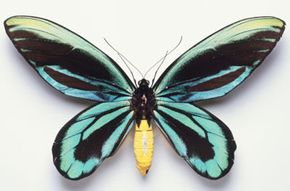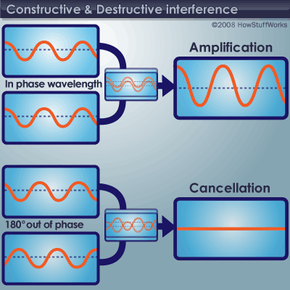Quck answer
Butterflies get their striking colors from pigment cells in their wings and scales. These pigments can reflect and absorb different wavelengths of light, creating a variety of colors. However, some butterflies also have structural coloration, which is created by the microscopic structure of their wing scales reflecting light in a particular way. Additionally, some species of butterflies have evolved to mimic the colors and patterns of toxic or unpalatable butterflies, helping them avoid predators.
Wild Animals

The Queen Alexandra’s birdwing butterfly has striking blue wings that are easily noticeable due to its 11-inch wingspan. Check out more insect pictures.
Colin Keates/Dorling Kindersley/Getty Images
Butterflies are known for their stunning displays of color in nature. Their wings, which shine and seem to change color as they fly from flower to flower collecting nectar, are brilliantly colored. Pilots flying above the rainforest can see the bright blues of South America’s morpho butterfly up to half a mile away [source: Vukusic]. A butterfly’s rich color can act as camouflage, a signal for mating, and a warning signal.
So, where do the vivid colors of butterfly wings come from? How are they able to have such intense hues?
Butterflies get their colors from two different sources: ordinary (or pigmented) color and structural color. Ordinary color comes from chemical pigments that absorb certain wavelengths of light and reflect others. For instance, chlorophyll colors plants green. The chlorophyll absorbs the blue and red colors of the spectrum, but not the green, which you see when it bounces back to your eye. Most butterflies get their different shades of brown and yellow from melanin, which is the same pigment that makes you tan in summer and gives some people freckles.
Butterfly wings’ structural color is what makes them so fascinating. This type of color comes from the specific structure of the butterflies’ wings, and it explains why butterfly colors seem to shift and appear so intense. This quality of changing colors as you, the observer, moves is known as iridescence, and it occurs more in nature than you might think. Mother of pearl seashells, fish, and peacocks are just a few examples of animals with this quality, but it is most pronounced in the butterfly family. It happens when light passes through a transparent, multilayered surface and is reflected more than once. The multiple reflections compound one another and intensify colors.
Find out how iridescence and the structure of butterfly wings work together to produce such incredible effects on the next page.
Iridescence in Nature

Constructive interference amplifies the colors of a butterfly’s wings.
HowStuffWorks
It is useful to remember that light is a wave and can be described as a wavelength when discussing iridescence. The distance between identical points on a wave is the wavelength. Waves can also be described by their phase, which is the position of their crests (high points) and troughs (low points). When two waves have the same phase, their crests and troughs would align if placed on top of one another.
You have probably seen iridescence before, even if you didn’t know what it was called. Perhaps you were fascinated by the colorful bubbles in your bathtub or while playing with a wand. The colors in soap bubbles are created by light reflecting off the top and bottom layers of the bubble. Depending on how long it takes for the second reflection to join the first, the waves of light may or may not line up. When they do line up, they have constructive interference and create intense colors. When they don’t, they have destructive interference and weaken or destroy the reflection.
Butterfly wings also use iridescence to create intense colors. The wings have thousands of microscopic scales, each with multiple layers that create numerous instances of constructive interference. This amplifies the effects of iridescence and creates the bright colors that we see in many species. The wings even have the ability to reflect ultraviolet light, which guides monarch butterflies on their migration. Some white coloring, like in human hair, is created from air bubbles scattering light rather than pigments.
The combination of both structural and pigmented colors on a butterfly can create fascinating effects. If you were to observe a butterfly with yellow pigment underneath a structure that produces a blue iridescent color, you may perceive a green tone resulting from the merging of the two colors. Depending on your perspective, you may also see blue, yellow, green, or a combination of the three as the butterfly moves its wings and light enters at different angles. Butterfly wings can exhibit various colors and patterns, serving as camouflage or communication, and owe their beauty to iridescence and structural color. To learn more about butterflies and iridescence, check out the links provided on the next page, which contain related articles, a butterfly quiz, and more great links. Sources for this information include Enchanted Learning and the University of Exeter, among others.
FAQ
1. How do butterflies get their bright colors?
Butterflies get their bright colors from the scales on their wings. These scales are made up of pigments and structural colors, which reflect and absorb different wavelengths of light. The pigments are made up of molecules that absorb certain colors and reflect others, giving the butterfly its characteristic hue. Structural colors, on the other hand, are created by the way light interacts with the scales. These colors are often more iridescent and can change depending on the angle of the light hitting the wings.
2. Can butterflies change their colors?
Butterflies cannot change their color once the scales on their wings have formed. However, some butterfly species can change the color of their wings as they age or when they are exposed to different temperatures. For example, the male Common Blue butterfly can appear blue or purple depending on the temperature during development. Some species can also appear different colors depending on the angle of the light hitting their wings due to the structural colors mentioned earlier.
3. Why do butterflies have bright colors?
Butterflies have bright colors as a form of communication and protection. The bright colors are often used to attract mates, signal to other butterflies, and warn predators of their toxicity. Some butterfly species also use their colors to blend in with their surroundings, making them harder to spot by predators. The bright colors are also important for thermoregulation, as darker colors absorb more heat and lighter colors reflect more heat.
4. How do butterfly colors vary by species?
Butterfly colors vary greatly by species and can range from bright blues and greens to muted browns and grays. The colors are often used to distinguish between different species, as well as between males and females. Some species have different color variations within their populations, which can be influenced by environmental factors such as temperature and humidity.
5. Do all butterflies have bright colors?
No, not all butterflies have bright colors. Some species have more muted colors, which can help them blend in with their surroundings or avoid attracting predators. Additionally, some species have evolved to have transparent or translucent wings, which allow them to be even harder to spot. However, many of the most well-known butterfly species, such as Monarchs and Swallowtails, have bright and striking colors.





Leave a Reply